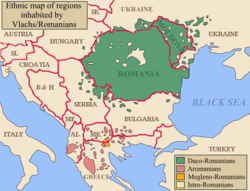Top Qs
Timeline
Chat
Perspective
Eastern Romance languages
Romance subfamily of Southeast Europe From Wikipedia, the free encyclopedia
Remove ads
The Eastern Romance languages[1] are a group of Romance languages. The group comprises the Romanian language (Daco-Romanian), the Aromanian language and two other related minor languages, Megleno-Romanian and Istro-Romanian.[2][3][4]
The extinct Dalmatian language (otherwise included in the Central Romance group) is sometimes included as part of the Eastern Romance group,[5][6][7] being considered a bridge between Italian and Romanian.[8][9] Some classifications of the Romance languages consider Eastern and Central Romance to form a clade (often simply called "Eastern Romance", with "Eastern Romance proper" referred to as Balkan or Daco-Romance),[1] but nowadays Central Romance are more often grouped with the Western Romance languages as "Italo-Western".
Remove ads
Languages
Summarize
Perspective
Eastern Romance comprises Romanian (or Daco-Romanian), Aromanian, Megleno-Romanian and Istro-Romanian, according to the most widely accepted classification of the Romance languages.[1][10][11][12][13] The four languages are sometimes labelled as dialects of Romanian[1] and developed from a common ancestor[13] known as Common Romanian.[14] They are surrounded by non-Romance languages.[15] Judaeo-Spanish (or Ladino) is also spoken in the Balkan Peninsula, but it is rarely listed among the other Romance languages of the region because it is rather an Iberian Romance language that developed as a Jewish dialect of Old Spanish in the far west of Europe, and it began to be spoken widely in the Balkans only after the influx of Ladino-speaking refugees into the Ottoman Empire in the 16th century.[12]
Internal classification
Within the Glottolog database, the languages are classified as follows:[16]
- Eastern Romance
- Aromanian
- Northern Romanian
- Eastern Romanian
- Istro-Romanian
Peter R. Petrucci, by contrast, states that Common Romanian had developed into two major dialects by the 10th century, and that Daco-Romanian and Istro-Romanian are descended from the northern dialect, while Megleno-Romanian and Aromanian are descended from the southern dialect.[17]
- Eastern Romance
- Northern Romanian
- Southern Romanian
Remove ads
Samples of Eastern Romance languages
Note: the lexicon used below is not universally recognized.
Remove ads
See also
References
Sources
Wikiwand - on
Seamless Wikipedia browsing. On steroids.
Remove ads

